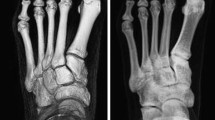Abstract
This study describes a method of detecting first metatarsal pronation on the basis of the movement of the inferior tuberosity of the base of 20 cadaveric first metatarsals at 0°, 10°, 20° and 30° pronation. On pronation, the inferior tuberosity of the base of the first metatarsal moved lateral to the mid-line axis. At 10°, the tuberosity pointed to the junction of the inner third and outer two-thirds of a line between the midpoint and lateral tubercle of the base. At 20°, it pointed to the junction of the inner two-thirds and outer third of that line. At 30°, it pointed to the outer margin of the lateral third. Using these features, the amount of first metatarsal pronation in 100 consecutive weight-bearing views of feet was recorded and plotted against the corresponding intermetatarsal angles in those feet. Four of 43 patients with an intermetatarsal angle of less than 9° had pronation greater than 10°, 48 of 57 patients with an intermetatarsal angle greater than 9° had pronation greater than 10° (P<0.001). As intermetatarsal angles increase, the amount of first metatarsal pronation increases (r= 0.69). Pronation and varus deviation of the first metatarsal are linked; both alter the tendon balance maintaining proximal phalanx alignment and lead to the development of hallux valgus.
Similar content being viewed by others
References
Antrobus JN (1984) The primary deformity in hallux valgus and metatarsus primus varus. Clin Orthop 184:251
Barnicot NA, Hardy RH (1955) The portion of the hallux in West Africans. J Anat 89:355
Bonney G, McNab I (1952) Hallux valgus and hallux rigidus, a critical survey of operative results. J Bone Joint Surg [Br] 34:366
Brahm SM (1988) Shape of the first metatarsal head in hallux rigidus and hallux valgus. J Am Podiatr Soc 78:300
Cholemeley J (1958) Hallux valgus in adolescents. Proc R Soc Med 51:23
Ebisui JM (1968) The first ray axis and the first metatarsophalangeal joint. J Am Podiatr Soc 58:160
Engle ET, Morion DJ (1931) Notes on the foot disorders among natives of Belgian Congo. J Bone Joint Surg 13:311
Gould N, Schneider W, Ashikaga T (1980) Epidemilogical survey of foot patterns in the continental United States 1978–1979. Foot Ankle 1:8
Haines RW, MdDougall A (1954) The anatomy of hallux valgus. J Bone Joint Surg [Br] 36:272
Hardy RH, Clapham JCR (1951) Observations on hallux valgus. J Bone Joint Surg [Br] 33:376
Hardy RH, Clapham JCR (1952) Hallux valgus predisposing anatomical causes. Lancet 1:1180
Kilmartin TE, Barrington RL, Wallace WA (1991) Metatarsus primus varus, a statistical study. J Bone Joint Surg [Br] 73:937
Mann RA, Coughlin MJ (1981) Hallux valgus — etiology, anatomy, treatment and surgical considerations. Clin Orthop 157:31
Shine I (1965) Incidence of hallux valgus in a partially shoewearing community. BMJ 1648
Sim-Fook L, Hodgson AR (1958) A comparison of foot forms among the non-shoe and the shoe wearing Chinese population. J Bone Joint Surg [Am] 40:1058
Author information
Authors and Affiliations
Rights and permissions
About this article
Cite this article
Eustace, S., O'Byrne, J., Stack, J. et al. Radiographic features that enable assessment of first metatarsal rotation: the role of pronation in hallux valgus. Skeletal Radiol. 22, 153–156 (1993). https://doi.org/10.1007/BF00206143
Issue Date:
DOI: https://doi.org/10.1007/BF00206143




